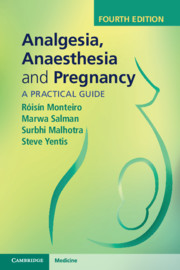Book contents
- Analgesia, Anaesthesia and Pregnancy
- Analgesia, Anaesthesia and Pregnancy
- Copyright page
- Contents
- Preface
- Section 1 Pre-conception and conception
- Section 2 Pregnancy
- I Procedures in Early and Mid-Pregnancy
- II Normal pregnancy and delivery
- III Operative Delivery and the Third Stage
- IV Anaesthetic problems
- V Problems confined to obstetrics
- VI Problems not confined to obstetrics
- Section 3 Puerperium and after
- Section 4 Organisational issues
- Index
- References
II - Normal pregnancy and delivery
from Section 2 - Pregnancy
Published online by Cambridge University Press: 29 April 2019
- Analgesia, Anaesthesia and Pregnancy
- Analgesia, Anaesthesia and Pregnancy
- Copyright page
- Contents
- Preface
- Section 1 Pre-conception and conception
- Section 2 Pregnancy
- I Procedures in Early and Mid-Pregnancy
- II Normal pregnancy and delivery
- III Operative Delivery and the Third Stage
- IV Anaesthetic problems
- V Problems confined to obstetrics
- VI Problems not confined to obstetrics
- Section 3 Puerperium and after
- Section 4 Organisational issues
- Index
- References
- Type
- Chapter
- Information
- Analgesia, Anaesthesia and PregnancyA Practical Guide, pp. 23 - 96Publisher: Cambridge University PressPrint publication year: 2019



